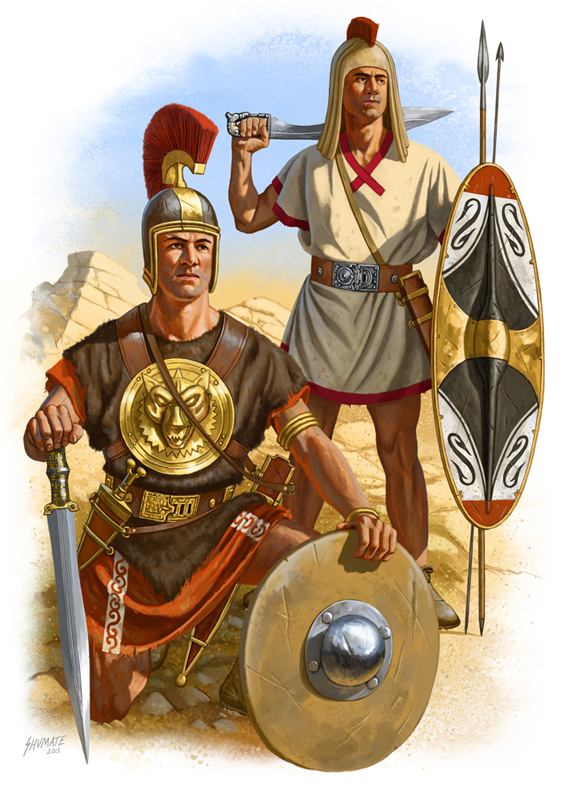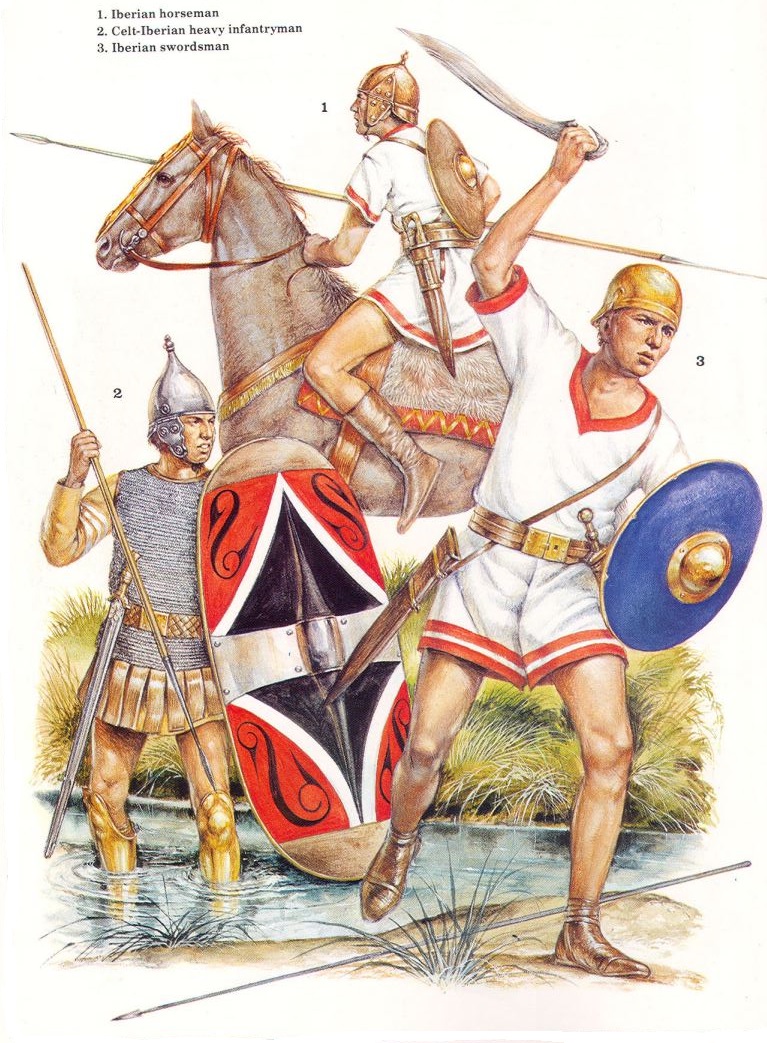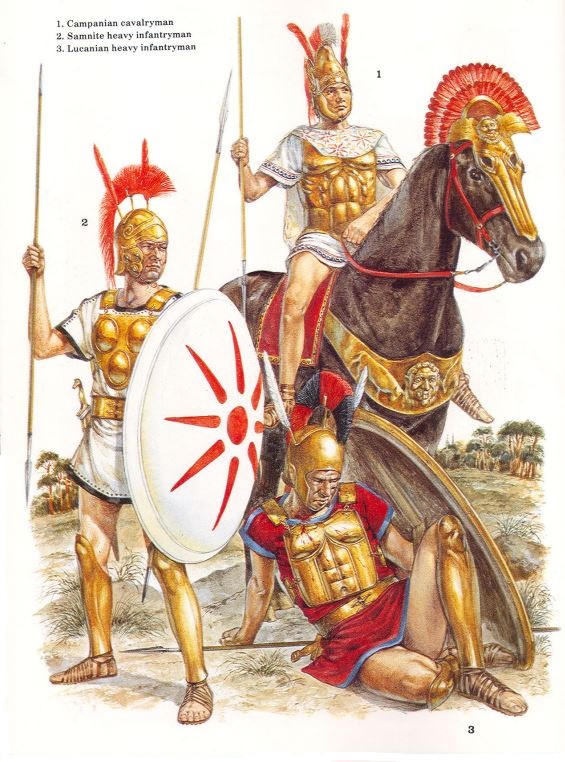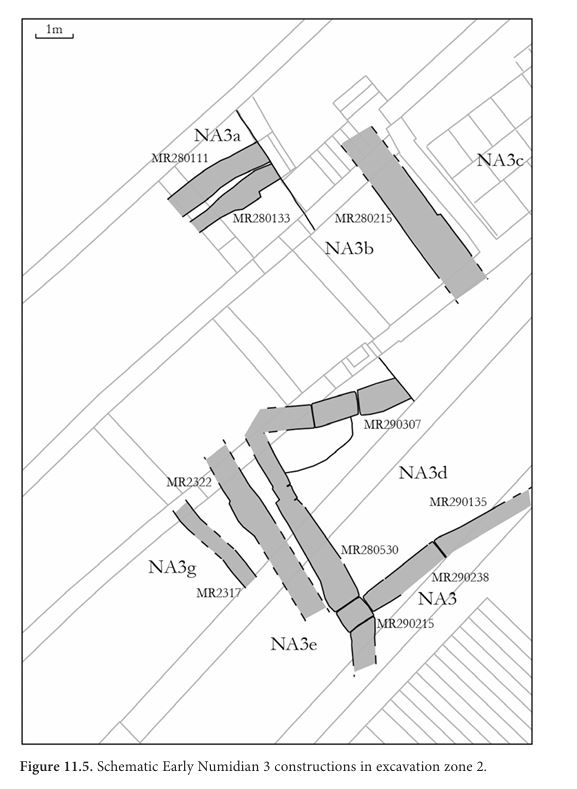Given the extensive representation of populations from the west. Med. in the Carthaginian army, it is not feasible to provide a comprehensive description of all of them. Therefore, I will focus on the key mercenary troops that frequently fought alongside the Carthaginians. 

1) The Iberians : In Thucydides' account (6.90.3), the Athenian general Alcibiades, praises Iberian mercenaries as some of the finest fighters available in the western Mediterranean. 

2 types of infantry among them : the caetrati, who constituted the light infantry armed with javelins (iron tip) and a small round shield with a metal boss, and the scutarii, which constituted the heavy infantry and who carried a flat oval shield similar to the roman scutum. 

The Scutarii could also carry javelins, and wielded the highly renowned falcata sword. The caetrati, on the other hand, were equipped with javelins, light shields (caetra), and falcata swords. The latter did not wear any armor.




Iberian warriors employed two types of swords: curved and straight. The first type, known as a falcata, was a variation of the Greek kopis. But Unlike the latter, it had a sharpened back edge near the tip, allowing for thrusting attacks. 

The second known as the "gladius hispanicus" by roman sources was a relatively short blade featured sharp edges on both sides and a long, tapered point suitable for stabbing. Encased in a framed scabbard, it was suspended from a waist belt using a stable ring suspension system. 

The Celtiberian forces were similarly equipped to the Iberians but fought with a mailed armor, a long, double-edged sword and a javelin made entirely of iron called the soliferreum. Additionally, they utilized incendiary weapons such as the falarica.




The famous Balearic slingers, known as the best slingers of ancient times, were first employed by Carthage around 337 BC. Since Carthage recognized the importance of long-range skirmishing, they considered them a valuable component of their armies. 

According to Strabo, the slings used by these warriors were crafted from hair or sinew, with each individual carrying three slings of varying thong lengths to accommodate different ranges. When not in use, the slings would be fastened around their heads. 

The ammunition consisted of stone, not lead like their Rhodian counterparts. They were carried in a bag slung over the shoulder. Diodorus reports a peculiar characteristic of these warriors, as they did not use currency and instead requested payment in the form of wine and women. 

2) The Celts : The Celtic warriors in the Carthaginian armies generally fought with a long double-edged sword made especially for slashing, javelins, short spears, large oval shields (leather-covered wood) and often wore little to no armor, which was seen as a sign of bravery. 

Shields were decorated and reinforced with embossed figures of animals in rolled bronze ; bronze helmets with high crests, horns, or figures of birds
and animals on the top; iron ringmail armour were often worn by the nobles.
and animals on the top; iron ringmail armour were often worn by the nobles.

Celts lacked a specific formation in battle and were often characterized as undisciplined. Their approach simply involved straight charges against the enemy, engaging in combat on a personal level. It is worth noting that their long slashing swords required ample space. 

Celtic warriors also used psychological techniques aimed to create a sense of terror such as matted hair, numerous horns/trumpets to produce an intimidating sound. They also achieved it by striking their swords against shields, accompanied by singing and wild screaming. 

3) The Oscans : Famous warriors comprising various peoples from southern Italy who frequently allied themselves against Rome alongside Carthage. They apparently had a reputation of being unscrupulous changing sides quite often. 

During the 4th and 3rd centuries, Campanian soldiers were equipped with either a thyreos-type shield featuring a central rib or a typical greek Aspis, a linothorax or muscle cuirass, and an Attic-style helmet adorned with a crest and feather on each side (geminae pinnae). 

Additionally they could wear a characteristic Oscan triple-disc cuirass with a broad Oscan belt and Graeco-Etruscan greaves with a Montefortino-type helmet. Main weapons consisted of javelins (iron tips) and short spears, while their swords were typically of the Greek kopis type. 

Here is a Campanian triple-disc cuirass discovered in a tomb at Ksour Essef in Tunisia. Dating back to the 3rd century BC, it is most likely a trophy brought back by a libyan veteran who fought in Hannibal's army. 

Greek mercenary infantry units gained prominence between 340 - 240 BC, after the defeat at Krimisos that highlighted the effectiveness of Greek hoplites. During the first Punic War, Carthage recruited Greek generals, notably Xanthippos from Sparta, to lead their troops. 

So as we've seen these mercenary regiments fought with their own equipment and tactics, led by their own officers who were under Carthaginian command. Interestingly, some of these foreign officers, like the Gallic chief Autaritus during the Mercenary War, could speak Punic. 

The Cavalry : The Carthaginian cavalry comprised Libyo-Phoenician forces as heavy cavalry, alongside notable Numidian auxiliaries serving as light cavalry, who demonstrated remarkable effectiveness during the Second Punic War in Italy.




From the 4th century BC, they constituted the majority of Carthaginian cavalry forces. Unarmored and wielding a small shield resembling the Iberian caetra, they relied on a handful of javelins tipped with iron and skillfully used a dagger to cut the leg tendons of their enemies.




Additionally, there were contingents of Mauretanian, Gaetulian, and Iberian cavalry, forming the light cavalry segment, while the heavy cavalry consisted of young Carthaginian aristocrats, the libyo-phoenician and celtic cavalrymen. 

The Libyo-Phoenician cavalry distinguished themselves from the Numidian cavalry through their utilization of saddles, long-sleeved tunics, Hellenistic-style muscle cuirasses, and large shields with an umbo. Reconstitution (right) of Ian heath based on a terracotta statuette :




END - part III will be about the War elephants and chariots, siege engines en standards.
Artists : Ian heath, Steve Noon, Clive Spong, Richard Hook, Manuel Krommenacker, Johnny Shumate, Jenny Dolfen, Peter Connolly, Kaya Gokberk
Artists : Ian heath, Steve Noon, Clive Spong, Richard Hook, Manuel Krommenacker, Johnny Shumate, Jenny Dolfen, Peter Connolly, Kaya Gokberk
@SuffeteIfriqi Thanks bro I really appreciate 👍
• • •
Missing some Tweet in this thread? You can try to
force a refresh










































